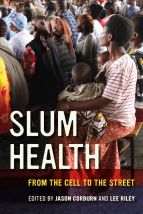Slum Health: From the Cell to the Street

The first page of Slum Health provides a kind of mission statement from the authors: “we aimed for Slum Health to be responsive to and offer a practical guide for all those interested in improving the lives of the urban poor around the world”.
Following this introduction, Part One covers background, summarizing the literature and activities related to slum health. These chapters include definitional and conceptual considerations, such as the contestation of the term “slum” itself. They explain the interface between the “cell” and the “street” of the title, or the biological vs. the complex web of political, social, cultural and economic factors that also shape health. And they describe general frameworks and measures to increase health equity, notably slum upgrading and coproduction of knowledge.
Parts Two through Four take a case study approach, focused on urban Brazil, India and Kenya. Despite these varied contexts, these sections all foreground the participation of the urban poor in interventions that seek to improve slum health, as well as their right to remain where they are. One example describes a coalition of slum dwellers, an NGO and academics working to upgrade sanitation infrastructure in Nairobi’s Mathare settlement. (Exceptions are the chapters on Leptospira and Streptococcus in Salvador, Brazil, which adopt a more biomedical approach than the other chapters.)
Part Five concludes by identifying four gaps in knowledge in the growing field of slum health:
- Research into the health issues likely to affect more and more slum residents
- Measurement of the disease burden in slums
- Policy changes to improve slum health
- Training on relevant research and advocacy
Here, Corburn and Riley map out a vision for a more integrated and inclusive approach to slum health, from integration of climate change to action research that is built into educational curricula. This evokes a sense of the urgency of such work, as (page 293):
“slums and slum dwellers are the majority of the population in many cities in emerging-economy countries, and unless their health is made a priority, inequities between rich and poor will grow, and arresting the spread of preventable disease and unnecessary suffering will be that much more challenging.”
Further reading:
Lilford, Richard J, Oyinlola Oyebode, David Satterthwaite, G J Melendez-Torres, Yen-Fu Chen, Blessing Mberu, Samuel I Watson, Jo Sartori, Robert Ndugwa, Waleska Caiaffa, Tilahun Haregu, Prof Anthony Capon, Ruhi Saith and Alex Ezeh (2016), “Improving the health and welfare of people who live in slums”, The Lancet Vol 389, No 10068, pages 559–570, available at http://thelancet.com/journals/lancet/article/PIIS0140-6736(16)31848-7/fulltext.
Moser, Caroline (2011), “Cancer note from the slums”, Environment and Urbanization Vol 23, No 1, pages 119–121, available at http://journals.sagepub.com/doi/pdf/10.1177/0956247811398594.
Scovronick, Noah, Simon J Lloyd and R Sari Kovats (2015), “Climate and health in informal urban settlements”, Environment and Urbanization Vol 27, No 2, pages 657–678, available at http://journals.sagepub.com/doi/full/10.1177/0956247815596502.
Sverdlik, Alice (2011), “Ill-health and poverty: a literature review on health in informal settlements”, Environment and Urbanization Vol 23, No 1, pages 123–155, available at http://journals.sagepub.com/doi/pdf/10.1177/0956247811398604.
Book note prepared by Christine Ro
Search the Book notes database
Our Book notes database contains details and summaries of all the publications included in Book notes since 1993 - with details on how to obtain/download.
Use the search form above, or visit the Book notes landing page for more options and latest content.
For a searchable database for papers in Environment and Urbanization, go to http://eau.sagepub.com/

